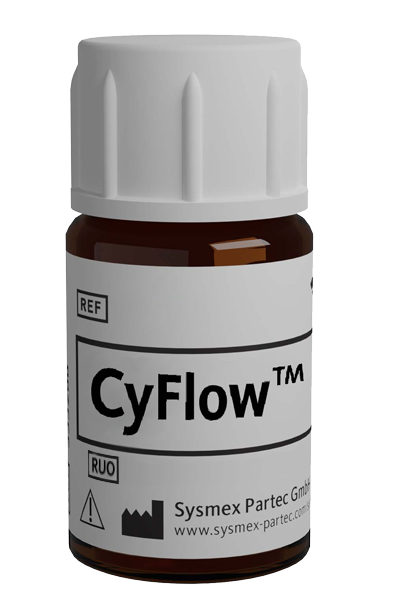CyFlow™ Lck Purified

| Antibody: | Yes |
| Antigen: | Lck |
| Application: | Flow cytometry, Immunocytochemistry, Immunoprecipitation, Western blot |
| Clonality: | monoclonal |
| Clone: | LCK-01 |
| Field of Interest: | Phosphorylation |
| Format/Fluorochrome: | Purified |
| Isotype: | IgG1 |
| Regulatory Status: | RUO |
| Source Species: | Mouse |
| Target Species: | Human |
| Product number: | BF393143 |
For Research Use Only
| Concentration Unit | mg/mL |
| Concentration | 1 |
| Quantity | 0.1 mg |
| Volume | 0.1 mL |
| Immunogen | Peptide corresponding to amino acids 22-36 in the sequence of human Lck |
| Background Information | Lck is a Src-family tyrosine kinase, which is essential for signaling through the T-cell receptor (TCR) complex. Upon TCR triggering, Lck phosphorylates the ITAM motives in its ζ subunits, establishing binding sites for the SH2 domains of the tyrosine kinase ZAP70, which is also phosphorylated by Lck and thereby activated to generate subsequent signaling platforms by phosphorylation of adaptor LAT. Whereas the majority of Lck is localized to the plasma membrane, there is also a significant fraction associated with the Golgi apparatus, which may contribute to Raf activation under conditions of weak stimulation through the TCR. Lck is also involved in the regulation of apoptosis induced by various stimuli, but not by the death receptors. |
| Storage Buffer | The reagent is provided in phosphate buffered saline (PBS) solution, pH ≈7.4, containing 0.09% (w/v) sodium azide. |
| Storage | Avoid prolonged exposure to light. Store in the dark at 2-8°C. Do not freeze. |
| Stability | Do not use after expiration date stamped on vial label. |
| Cebecauer M, Cerny J, Horejsi V: Incorporation of leucocyte GPI‑anchored proteins and protein tyrosine kinases into lipid‑rich membrane domains of COS‑7 cells. Biochem Biophys Res Commun. 1998 Feb 24; 243(3):706‑10. < PMID: 9500981 > | Denny MF, Kaufman HC, Chan AC, Straus DB: The lck SH3 domain is required for activation of the mitogen‑activated protein kinase pathway but not the initiation of T‑cell antigen receptor signaling. J Biol Chem. 1999 Feb 19; 274(8):5146‑52. < PMID: 9988764 > | Romagnoli P, Strahan D, Pelosi M, Cantagrel A, van Meerwijk JP: A potential role for protein tyrosine kinase p56(lck) in rheumatoid arthritis synovial fluid T lymphocyte hyporesponsiveness. Int Immunol. 2001 Mar; 13(3):305‑12. < PMID: 11222499 > | Brdicková N, Brdicka T, Angelisová P, Horváth O, Spicka J, Hilgert I, Paces J, Simeoni L, Kliche S, Merten C, Schraven B, Horejsí V: LIME: a new membrane Raft‑associated adaptor protein involved in CD4 and CD8 coreceptor signaling. J Exp Med. 2003 Nov 17; 198(10):1453‑62. < PMID: 14610046 > | Hur YG, Yun Y, Won J: Rosmarinic acid induces p56lck‑dependent apoptosis in Jurkat and peripheral T cells via mitochondrial pathway independent from Fas/Fas ligand interaction. J Immunol. 2004 Jan 1; 172(1):79‑87. < PMID: 14688312 > | Gruber C, Henkel M, Budach W, Belka C, Jendrossek V: Involvement of tyrosine kinase p56/Lck in apoptosis induction by anticancer drugs. Biochem Pharmacol. 2004 May 15; 67(10):1859‑72. < PMID: 15130763 > | Lovatt M, Filby A, Parravicini V, Werlen G, Palmer E, Zamoyska R: Lck regulates the threshold of activation in primary T cells, while both Lck and Fyn contribute to the magnitude of the extracellular signal‑related kinase response. Mol Cell Biol. 2006 Nov; 26(22):8655‑65. < PMID: 16966372 > | Meraner P, Horejsí V, Wolpl A, Fischer GF, Stingl G, Maurer D: Dendritic cells sensitize TCRs through self‑MHC‑mediated Src family kinase activation. J Immunol. 2007 Feb 15; 178(4):2262‑71. < PMID: 17277131 > | Li M, Ong SS, Rajwa B, Thieu VT, Geahlen RL, Harrison ML: The SH3 domain of Lck modulates T‑cell receptor‑dependent activation of extracellular signal‑regulated kinase through activation of Raf‑1. Mol Cell Biol. 2008 Jan; 28(2):630‑41. < PMID: 17998336 > | Kim MJ, Park MT, Yoon CH, Byun JY, Lee SJ: Activation of Lck is critically required for sphingosine‑induced conformational activation of Bak and mitochondrial cell death. Biochem Biophys Res Commun. 2008 May 30; 370(2):353‑8. < PMID: 18371298 >
